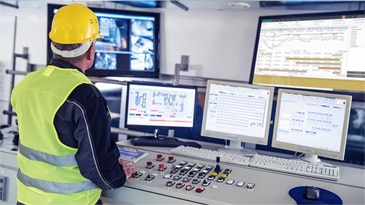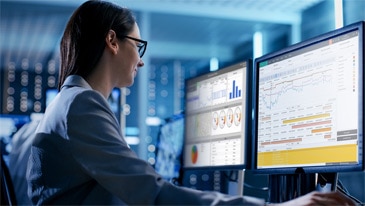22 May 2018
This text is the English translation of the official Turkish version of the applicable press release. It has been prepared solely as a reference and ease of use. Please refer to the original Turkish text for details and/or attributes. In case of any incongruity, original Turkish version shall prevail.
New generation control technologies for water and waste water management
Mitsubishi Electric introduced innovative water automation solutions at IFAT 2018
Technology leader Mitsubishi Electric displayed its new generation solutions that reduce complex water and waste water management processes, supporting efficiency in IFAT 2018 fair organized in Munich, Germany. Aquatoria; process management which took place among the brand's featured technologies in the fair, provides balanced distribution across urban distribution networks with its design which includes process management, visualisation and control packages. Thus, while considerably improving water service levels, prevents leaks and reduces energy usage.

Kilometers of pipes have to be used in order to connect numerous control valves, pumping stations and processing facilities present in water supply networks together. This poses a big challenge when operators need to harmonise system pressure to avoid leakage, and make sure each station is working as energy efficiently as possible. Rising energy prices and the increasing cost of maintenance work force water and waste water companies to find new solutions that do not drain financial, personnel and material resources. Operators must be able to evaluate all assets such as a pump system, a distribution network, or an entire processing facility to benchmark performance and then start to make measurable improvements Providing businesses with high added value by reducing such complex processes in water and waste water management and supporting efficiency, Mitsubishi Electric introduced its new generation technologies aimed at water automation in IFAT 2018 fair which was organized in Munich, Germany, on 14 - 18 May.
Efficient water management with artificial intelligence
Automation process, which is a reflection of digital conversion, helps increase control and efficiency levels in water and waste water management. In the application, by adding software layer to the equipments connected to a network, it is made possible to run all equipments connected to the automation in a coordination. Smart devices such as inverters and PLCs together with a set of sensors provide the data and feedback required for a detailed visualisation of an entire network or system. Thus, real-time control is provided. Aquatoria, the new generation solution of Mitsubishi Electric introduced in IFAT Fair provides all mentioned operational advantages. Management and optimization of the software developed specifically to meet key challenges faced by the water industry is made by an artificial intelligence (AI) function.
Thus, efficiency in water networks increase, costs drop
The innovative software helps maintain ideal water quality while reducing possible leaks by precisely controlling system pressure. Thus, it improves operational efficiencies in water networks and delivers significant reductions in costs. The software which can be configured to identify equipments that can't provide desired efficiency, can automatically optimise active pumping stations while controlling and managing pressure. As a result, a significant reduction can be achieved in energy usage.
Field management and control gets easier

Efficient management of the whole water distribution system is made possible when both water and process data flow concurrently to give a real-time picture. When it comes to optimisation of energy consumption, leak detection or asset management, a perfectly structured communication system between facilities and the control room plays a vital role. Providing a structure for those improvements, Aquatoria offers a software platform based on Mitsubishi Electric's SCADA system, which provides the robustness of a proven industrial automation tool with the flexibility to accommodate different application set-ups. From an operator point of view, information is presented on clear graphical user interfaces (GUIs) as well as control room displays that can be modified easily to represent changes to the infrastructure. The Geo Module for example offers an interactive map that shows the geographic location of each facility, this helps the user to manage and control the sites, but also makes it easy to add or change the information presented on the display.
Six software modules are present
In addition to the GEO module and the AI based Adoptive Control module, there are four other software modules that are part of Aquatoria. These include a configuration module for adding and amending assets, and a pumping selection module that allows for manual intervention of each pumping asset to balance duty, efficiency and service-life. There is also an analytics module used for alarm setting and general monitoring, which works with infrastructure diagnostics module which checks and backs-up control parameters.
Ideal solution for developing control systems in water management and waste facilities

Numerous applications in water management facilities might make it necessary to use a process management system with broad visualisation capabilities. The PMSX®pro Decentralised Control System (DCS) provides control via Mitsubishi Electric PLC platforms and combines this with equally advanced visualisation capabilities. This feature shows itself as the solution for upgrading control systems at water management and treatment facilities. New options such as topological line colouring (TLC) allow users to create system plan diagrams with dynamic on-screen functions which are easy to understand and convey visual information quickly. As a result, operators gain absolute control advantage along with the opportunity of a clear process overview. This provides live status for fast maintenance and management decisions, increasing plant up-time and more efficient operations.
Smart inverters
Capital expenditure on automation equipment can also be reduced by using the FR-F800 series of inverters with integrated Ethernet which are used to improve performance of pumps or motors by utilising built in PLC software. PLC functions enable the inverter to control and co-ordinate the whole complete process without the need to purchase an additional physical PLC controller. Direct Human Machine Interface (HMI) compatibility and flexible networking options add to the system-building potential. When the energy saving feature of FR-F800 inverter is combined with the system capability, it delivers an all-round package of process optimisation and cost reduction.
Predictive maintenance to reduce unscheduled downtime
While visualising an entire plant in real-time is very effective for controlling costs, seeing into the future is considered to be an even bigger advantage. Thanks to predictive maintenance techniques, operators responsible for improving the availability of equipment such as pumps and other rotating equipment can minimise unscheduled downtime. Reducing downtime helps control costs and ensure customer service targets are met. The Smart Condition Monitoring (SCM) kits from Mitsubishi Electric provide an integrated approach for monitoring the condition of individual assets that enables service requirements to be predicted accurately and realized as necessary. This way, service planning for equipments is realized as required, unexpected breakdowns are avoided, and much more efficient and easy maintenance planning is made.
Note that the releases are accurate at the time of publication but may be subject to change without notice.
